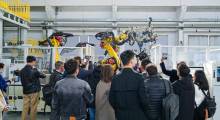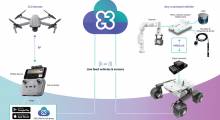As high-speed, low-latency wireless networking spreads, the distribution of compute between the cloud and the edge could shift and lead to smarter robots. Kollmorgen yesterday said it is performing 5G tests with Ericsson to explore future mobile robot capabilities.
“We want to continue to push the boundaries of mobile robot applications with our NDC Solutions platform,” said Peter Bladh, director of research and development at Kollmorgen. “5G holds the key to unlock more advanced routing of intralogistics, generate better insights, improve predictive maintenance, and speed up commissioning. It is also likely going to be the future standard of industrial communication infrastructure.”
The Radford, Va.-based company said its NDC platform enables vehicle builders such as Toyota Material Handling Europe, Jungheinrich AG, and Mitsubishi Logisnext Europe Oy (Rocla) to create autonomous logistics automation. With Kollmorgen NDC, companies can automate virtually any type of vehicle or robot and integrate it for any materials handling application, in any industry, worldwide, it claimed.
5G offers robot advantages
5G could enable new levels of artificial intellligence and machine learning, simplify infrastructure requirements, and increase network stability, said Kollmorgen. The company said it could “dramatically increase performance and cost efficiency” for its partners and end users.
5G has several advantages compared to Wi-Fi, noted Kollmorgen. Its higher bandwidth allows for the exchange of more data, and its low latency lets heavy computations move to the cloud. As a result, computational performance would not be limited by a mobile robot's onboard processing, enabling new levels of computer vision and deep learning, said the company.
In addition, 5G could result in better scalability and cost savings, as the advanced computations would not require expensive local servers, said Kollmorgen. Next-generation wireless infrastructure is also potentially easier to set up than Wi-Fi, and it could have more robust and reliable coverage, it said. 5G could also allow localization in dynamic environments without requiring artificial landmarks.
Kollmorgen tests 5G with Ericsson
Kollmorgen said its tests with Ericsson were carried out on both a private 5G network, as well as a public 4G network, with an autonomous mobile robot (AMR) controlled by the Kollmorgen NDC S platform. The Wi-Fi communication link in the Kollmorgen CVC700 onboard vehicle control unit was replaced with a 5G communication link.
“[The] test results were promising,” said the company. “The NDC Solutions hardware and software proved to run as stable on 5G as on Wi-Fi. Furthermore, a seamless 5G antenna handover was observed. This is an important observation, as stable roaming between access points is a recurring challenge while configuring Wi-Fi networks for fast-moving mobile robot applications.”
“These tests are just the beginning of our 5G journey,” said Bladh. “Our initial aim was to prove that our NDC Solution platform is agnostic to the type of communication link used and explore the performance differences between 5G and Wi-Fi. Having done so, we are confident to say that NDC Solutions is 5G ready.”
“Autonomous material handling requires both powerful and secure connectivity, and a robust ecosystem of application providers,” said Thomas Noren, head of dedicated networks at Ericsson. “Ericsson is proud to partner with Kollmorgen to enable automatic guided vehicles [AGVs] with industry-grade reliable connectivity from Ericsson Private 5G, ensuring smooth and safe operations.”
Stockholm-based Ericsson said its portfolio includes networks, digital services, managed services, and emerging business. The telecommunications provider said its investments in innovation have delivered telephony and mobile broadband to billions of people around the world. Kollmorgen joined Ericsson's Industry 4.0 partner program last April.
Article topics
Email Sign Up

















